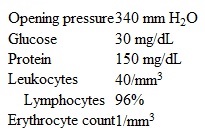A 34-year-old man is brought to the emergency department due to 3 weeks of intermittent fever, headache, malaise, and night sweats. Over the last few days, his headaches have worsened, and he has had blurry and double vision. The patient uses injection drugs and was treated for staphylococcal endocarditis 4 years ago. Temperature is 38.1 C (100.6 F) , blood pressure is 150/100 mm Hg, pulse is 66/min, and respirations are 18/min. BMI is 18.4 kg/m2. The patient is ill in appearance and somnolent but easily arousable and oriented. There are white plaques on the oropharyngeal mucosa and several skin lesions resembling molluscum contagiosum. There is increased resistance to passive neck flexion. Neurologic examination reveals leftward gaze restriction in the left eye but no other focal weakness or sensory loss. Funduscopy reveals bilateral papilledema. A noncontrast CT scan of the head shows no abnormalities. The patient receives a lumbar puncture; results of the spinal fluid analysis are as follows:  The patient is hospitalized and antimicrobial therapy is administered. Further cerebrospinal fluid studies confirm the diagnosis, and the patient is also found to be HIV positive with a CD4 count of 26/mm3. He had initial symptom relief but the severe headache returned, and he has also started to experience worsening nausea, vomiting, and lethargy. Neurologic examination shows no new focal deficits. Which of the following is the best next step in management of this patient?
The patient is hospitalized and antimicrobial therapy is administered. Further cerebrospinal fluid studies confirm the diagnosis, and the patient is also found to be HIV positive with a CD4 count of 26/mm3. He had initial symptom relief but the severe headache returned, and he has also started to experience worsening nausea, vomiting, and lethargy. Neurologic examination shows no new focal deficits. Which of the following is the best next step in management of this patient?
Definitions:
Q23: A 16-year-old girl comes to the office
Q32: A 15-year-old boy is brought to the
Q114: A 65-year-old postmenopausal woman comes to the
Q136: A 72-year-old Caucasian male comes to your
Q363: A 50-year-old woman comes to the office
Q537: A 29-year-old woman, gravida 2 para 0
Q622: An 8-year-old girl is brought to the
Q833: A 34-year-old woman comes to the office
Q861: A 58-year-old Caucasian man comes to the office
Q875: A 17-year-old girl comes to the office